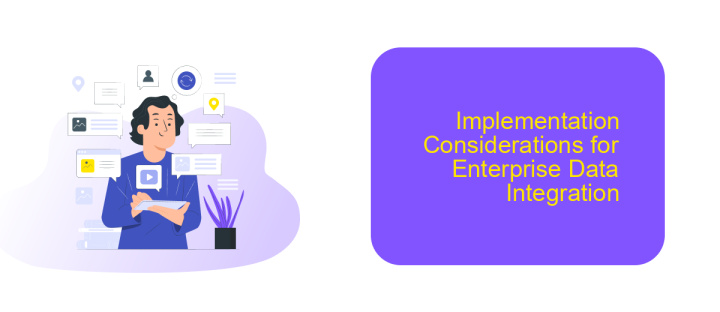Enterprise Data Integration
Enterprise Data Integration (EDI) is a crucial process that enables organizations to consolidate data from various sources into a unified view. By seamlessly integrating disparate data systems, EDI enhances decision-making, improves operational efficiency, and fosters innovation. This article explores the importance, challenges, and best practices of enterprise data integration, providing insights into how businesses can leverage it to gain a competitive edge.
Introduction
Enterprise Data Integration is a crucial aspect of modern business operations, enabling organizations to consolidate data from various sources into a unified view. This process enhances decision-making, improves efficiency, and ensures data consistency across the enterprise. By integrating data, companies can leverage insights that drive strategic initiatives and operational excellence.
- Centralized data management
- Improved data quality and consistency
- Enhanced decision-making capabilities
- Streamlined business processes
- Increased operational efficiency
One of the tools that facilitate seamless data integration is ApiX-Drive. This service allows businesses to automate data workflows between different applications without the need for coding. By using ApiX-Drive, companies can effortlessly connect various systems, ensuring that data flows smoothly and is always up-to-date. This not only saves time but also reduces the risk of errors, making it an invaluable asset for enterprise data integration.
Drivers and Challenges of Enterprise Data Integration

Enterprise data integration is driven by the need for seamless data flow across various systems, enabling organizations to make informed decisions and gain a competitive edge. The increasing volume and variety of data, along with the demand for real-time analytics, necessitate robust integration solutions. Tools like ApiX-Drive facilitate this process by offering user-friendly interfaces and automated workflows, reducing the complexity of integrating disparate data sources.
However, there are significant challenges in achieving effective data integration. Data silos, inconsistent data formats, and security concerns can hinder the integration process. Moreover, the lack of standardized protocols and the need for continuous monitoring and maintenance add to the complexity. Despite these challenges, leveraging advanced integration platforms like ApiX-Drive can streamline the process, ensuring data consistency and reliability across the enterprise.
Components of an Enterprise Data Integration Architecture

Enterprise Data Integration (EDI) architecture is essential for consolidating data from various sources to ensure seamless business operations. The architecture typically comprises several critical components, each playing a unique role in the data integration process.
- Data Sources: These are the origins of data, including databases, applications, and external systems.
- Data Integration Tools: Tools like ApiX-Drive facilitate the connection and synchronization of diverse data sources, enabling automated workflows and real-time data updates.
- Data Transformation: This component involves converting data into a consistent format to ensure compatibility across systems.
- Data Storage: Centralized repositories such as data warehouses or data lakes store integrated data for easy access and analysis.
- Data Governance: Policies and procedures to ensure data quality, security, and compliance.
- Data Delivery: Mechanisms to distribute processed data to various endpoints, including business intelligence tools and end-user applications.
Each component of the EDI architecture plays a vital role in ensuring that data flows seamlessly across the enterprise, enabling informed decision-making and operational efficiency. Utilizing tools like ApiX-Drive can significantly streamline the integration process, ensuring that data from disparate sources is harmonized and readily accessible.
Implementation Considerations for Enterprise Data Integration

Implementing enterprise data integration requires careful planning and consideration of various factors to ensure seamless data flow across systems. One of the primary considerations is the compatibility of existing systems and the ability to integrate them without significant disruptions to ongoing operations. It's essential to evaluate the data formats, protocols, and standards used by different systems to ensure smooth data exchange.
Another crucial aspect is data security and compliance. Organizations must ensure that data integration processes adhere to regulatory requirements and maintain data privacy. Implementing robust encryption and access control mechanisms can help protect sensitive information during transfer and storage.
- Assess system compatibility and data formats
- Ensure data security and compliance
- Plan for scalability and future growth
- Utilize integration platforms like ApiX-Drive
Scalability is another important consideration, as the integration solution must be able to handle increasing data volumes and evolving business needs. Utilizing integration platforms such as ApiX-Drive can simplify the process by providing pre-built connectors and automated workflows, reducing the time and effort required for integration. By addressing these considerations, organizations can achieve effective and efficient enterprise data integration.


Benefits and Use Cases of Enterprise Data Integration
Enterprise Data Integration offers numerous benefits, including improved data accessibility, enhanced decision-making, and operational efficiency. By integrating disparate data sources, organizations can create a unified view of their data, enabling real-time insights and more informed strategic decisions. This integration also reduces data redundancy and ensures consistency across various systems, leading to more accurate analytics and reporting. Furthermore, automation of data workflows minimizes manual intervention, reducing errors and saving time.
Use cases of enterprise data integration span across multiple industries. For instance, in healthcare, integrating patient records from various departments ensures comprehensive patient care. In retail, combining sales data with inventory management systems optimizes stock levels and enhances customer experience. Services like ApiX-Drive facilitate these integrations by offering a user-friendly platform to connect different applications and automate data flows without requiring extensive technical knowledge. This makes it easier for businesses to implement and manage their data integration strategies, ensuring seamless and efficient operations.
FAQ
What is Enterprise Data Integration?
Why is Enterprise Data Integration important?
What are the common challenges in Enterprise Data Integration?
How can automation tools help in Enterprise Data Integration?
What factors should be considered when choosing an Enterprise Data Integration tool?
Apix-Drive is a universal tool that will quickly streamline any workflow, freeing you from routine and possible financial losses. Try ApiX-Drive in action and see how useful it is for you personally. In the meantime, when you are setting up connections between systems, think about where you are investing your free time, because now you will have much more of it.

